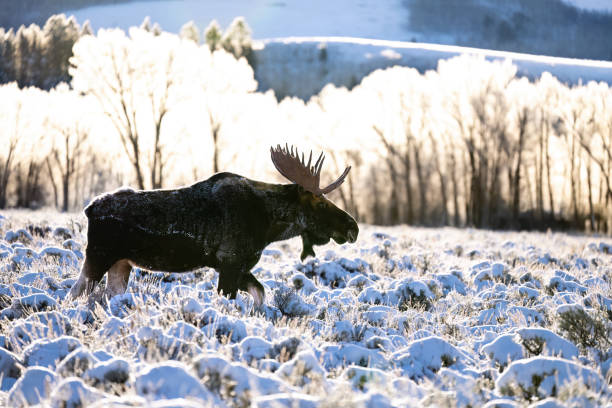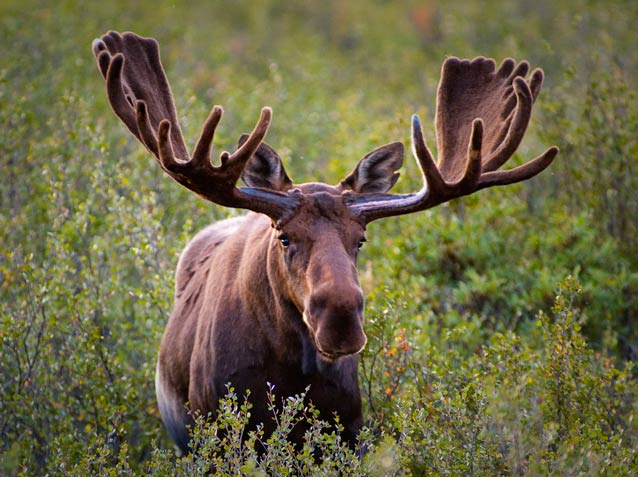Moose rutting season usually occurs in late September to early October in northern regions. It’s a time when male moose compete for mating rights with females and display aggressive behavior.
The rutting season is a crucial period for moose population dynamics and survival, as it determines the success of breeding for the upcoming year. During this time, male moose can be highly vocal, exhibiting dominance through vocalizations and physical displays like antler thrashing and posturing.
This behavior can attract female moose and intimidate rival males. The rutting season is an incredible spectacle of nature, showcasing the strength and resilience of these majestic creatures in the wild.

Credit: www.istockphoto.com
Telltale Signs Of Moose Rutting Season
Moose become more aggressive during rutting season, exhibiting territorial behaviors.
- Males often engage in sparring matches to establish dominance.
- Females may display increased restlessness and alertness.
Moose use vocal cues to communicate during rutting season.
- Males emit deep, guttural calls to attract mates.
- Females respond with softer calls to signal receptiveness.
Moose Rutting Season Timeline
Moose rutting season typically occurs in early fall, usually from mid-September to mid-October. During this time, male moose become more aggressive and territorial as they compete for mating opportunities. It’s essential to be cautious when in moose habitats during rutting season to avoid potential confrontations.
Moose rutting season is an intriguing phenomenon that occurs annually in the wilderness. Let’s delve into the Moose Rutting Season Timeline to understand the three distinct phases that characterize this behavior in these majestic creatures.Pre-rut Phase
During the pre-rut phase, which typically begins in late summer, male moose start preparing for the upcoming mating season. They engage in activities such as rubbing their antlers on trees to mark their territory and communicate their presence to potential mates.Peak Rut Phase
The peak rut phase is the most intense period of the rutting season, usually occurring in early fall. This is when male moose are most aggressive and vocal as they compete for the attention of female moose in estrus. Intense battles between males can often be observed during this phase.Post-rut Phase
Once the peak rut phase subsides, the post-rut phase sets in. Male moose start to calm down as the mating season winds down. They may continue to monitor their territory and look for any remaining opportunities to mate before the season comes to an end. In conclusion, understanding the Moose Rutting Season Timeline provides valuable insights into the fascinating behavior of these animals in the wild.Factors Affecting Rutting Season
Moose rutting season is influenced by factors like daylight length and temperature change. Typically, it occurs in the fall.
Factors Affecting Rutting Season Moose rutting season, also known as the mating season, is influenced by various environmental and mating dynamics. Understanding the factors affecting rutting season can help us appreciate the behaviors of these majestic creatures and the impact they have on their habitat.Environmental Influences
The rutting season of moose is heavily influenced by environmental factors. Seasonal changes, in particular, play a crucial role. The onset of rutting season is often synchronized with the transition to autumn, marking the decline in daylight hours. This triggers hormone production in moose, signaling the onset of rut. Additionally, a moose’s rutting behavior is affected by temperature, precipitation, and food availability. Colder temperatures accelerate the onset of rut, while food scarcity can have a delaying effect.Mating Dynamics
Mating dynamics also play a significant role in moose rutting season. As the rut approaches, male moose engage in thrashing behaviors, rubbing their antlers against trees to mark their territories and attract females. The competition for mating rights leads to aggressive interactions between males, sometimes resulting in injuries. The females enter estrus or heat, during which they become receptive to mating. This leads to a peak in mating activity as bulls actively seek out receptive cows. Understanding the factors influencing rutting season is crucial for conservation efforts and managing human-moose interactions. By respecting the natural behaviors of moose during rutting season, we can help ensure the safety and preservation of these iconic animals in the wild.Role Of Moose Rutting Season In Ecosystem
The moose rutting season, which typically occurs in the fall, plays a crucial role in maintaining the balance and health of the ecosystem. This annual mating period is marked by intense competition, vocal displays, and aggressive behavior among male moose, commonly known as bulls. Let’s explore the impact of moose rutting season on the moose population and its ecological significance.
Impact On Moose Population
During moose rutting season, male moose compete fiercely for the attention of female moose, known as cows. This intense contest ensures that only the strongest and fittest males are able to mate, ultimately leading to the survival of the fittest genes within the moose population. The competition among bulls also serves to prevent overpopulation, as only a limited number of males are successful in mating with the females.
Moose rutting season also has an impact on the demographics of the moose population. The successful mating of bulls with cows results in the birth of calves in the following spring. The timing of rutting season ensures that the calves are born in favorable conditions, with ample food available during the summer months. This timing also helps minimize predation of the vulnerable newborns, as they are born when predators are less active.
However, the intense nature of moose rutting season can also have negative consequences for the moose population. The aggressive behaviors exhibited by males can lead to injuries or even death, especially in cases of intense fighting. Additionally, the energy expended during this period can leave the male moose weakened and more susceptible to predators and harsh winter conditions. Thus, moose rutting season is a crucial period that shapes the dynamics and overall health of the moose population.
Ecological Significance
The moose rutting season has broader ecological significance beyond its impact on the moose population. By ensuring that only the strongest males reproduce, the rutting season contributes to the overall genetic health of the moose population. This natural selection process helps the moose adapt and evolve, ensuring their long-term survival in their changing environment.
Furthermore, the activities associated with rutting season can have indirect effects on other species within the ecosystem. The vocal displays of male moose during this period can serve as a form of communication, both attracting potential mates and warning off rival males. These sounds, along with the scent markings left by the bulls, act as signals to other animals, providing information about territory boundaries and breeding opportunities.
The intense competition among male moose during rutting season can also have cascading effects on the ecosystem. The physical altercations and display of dominance by the bulls can lead to changes in vegetation as trees and shrubs may be damaged or pushed over. This can create new openings in the forest, allowing for the growth of different plant species and potentially benefiting other herbivorous animals in the area.
Overall, the moose rutting season is a critical event in the life cycle of these majestic creatures. It not only shapes the dynamics of the moose population but also influences the broader ecosystem in significant ways. Understanding and appreciating the role of moose rutting season is essential for the conservation and management of this iconic species and their habitats.
Tips For Observing Moose Rutting Season
Moose rutting season typically occurs in the fall, during September and October. To observe this unique behavior, venture to areas with dense vegetation near bodies of water. Keep a safe distance and avoid disturbing the moose during this time. Happy moose watching!
Selecting Ideal Locations
When planning to observe moose rutting season, it is crucial to choose the ideal locations. Moose are known to gather in certain areas during this season, providing fantastic opportunities to witness their incredible behavior.
To select the best locations for observing moose rutting season:
- Research moose habitats in your region and identify areas with high moose populations. This will increase your chances of encountering these majestic creatures.
- Look for wetlands, marshes, or lakeshores, as moose are drawn to these areas for feeding and mating.
- Consider visiting national parks or wildlife reserves that have designated moose observation areas. These locations often provide guided tours or knowledgeable staff who can offer valuable insights.
By carefully selecting your observation locations, you can enhance your chances of witnessing the stunning displays of the moose rutting season.
Safety Precautions
While observing moose during rutting season can be an exciting endeavor, it is important to prioritize safety. These big and powerful animals should be observed with caution, as they can exhibit aggressive behavior during this time.
Here are some safety precautions to keep in mind:
- Keep a safe distance of at least 50 yards (150 feet) from moose. This ensures you don’t disturb their natural behavior and minimizes the risk of potential attacks.
- Do not approach moose calves, as the mothers are highly protective and may become aggressive if they perceive a threat.
- Stay alert and avoid sudden movements or loud noises that might startle the moose.
- If you encounter a moose that appears stressed or agitated, slowly back away and give it space.
By adhering to these safety precautions, you can observe moose rutting season from a safe distance while minimizing the risk of dangerous encounters.

Credit: www.nps.gov

Credit: www.kawdyoutfitters.com
Frequently Asked Questions Of When Is Moose Rutting Season
When Is Moose Rutting Season?
Moose rutting season typically occurs in the fall, usually between September and October. During this time, male moose engage in intense competition for mates, displaying dominance through vocal calls and sparring with their antlers. It’s an incredible sight to witness these majestic creatures in their natural habitat.
Conclusion
Understanding moose rutting season is essential for wildlife enthusiasts. By being aware of these behaviors, we can appreciate and respect the natural cycles of these majestic animals. For those hoping to witness this spectacle, timing and safety are key. Embracing nature’s rhythms fosters a deeper connection with our wild surroundings.



